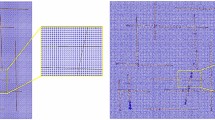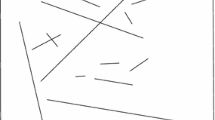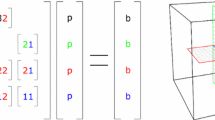Abstract
The multiscale finite volume method for discrete fracture modeling in highly heterogeneous porous media is developed. Multiscale methods are sensitive to the heterogeneity contrasts in both matrix and fracture networks. To resolve this, efficient algorithms for generating adaptive unstructured coarse grids are devised. First, primal coarse grids are independently constructed for the matrix and lower dimensional fractures. Then, flexible dual coarse grids are generated based on the fracture and matrix permeability features. Since the proposed algorithms employ the equivalent graph of unstructured grids, the same coarse grid generation strategy is applied for the fractures and matrix domains. Permeability-adapted coarse grids significantly improve the monotonicity behavior of MSFV method in highly heterogeneous fractured porous media. The performance of the method is assessed through several challenging test cases with highly heterogeneous permeability field in both fractures and matrix domain. Numerical results indicate that the extended MSFV method with adaptive unstructured coarse grids is a significant development for accurate flow simulation in heterogeneous fractured media using DFM approach.




























Similar content being viewed by others
References
Karimi-Fard M, Durlofsky L, Aziz K (2004) An efficient discrete-fracture model applicable for general-purpose reservoir simulators. SPE J 9:227–236
Reichenberger V, Jakobs H, Bastian P, Helmig R (2006) A mixed-dimensional finite volume method for two-phase flow in fractured porous media. Adv Water Resour 29:1020–1036
Geiger-Boschung S, Matthai SK, Niessner J, R. (2009) Helmig, black-oil simulations for three-component, three-phase flow in fractured porous media. SPE J 14:338–354
Ahmed R, Edwards MG, Lamine S, Huisman BAH, Pal M (2015) Controlvolume distributed multi-point flux approximation coupled with a lowerdimensional fracture model. J Comput Phys 284:462–489
Hou TY, Wu X-H (1997) A multiscale finite element method for elliptic problems in composite materials and porous media. J Comput Phys 134:169–189
Jenny P, Lee SH, Tchelepi HA (2003) Multi-scale finite-volume method for elliptic problems in subsurface flow simulation. J Comput Phys 187:47–67
Efendiev Y, Hou TY (2009) Multiscale finite element methods: theory and applications. Springer, Berlin
Hajibeygi H, Olivares MB, HosseiniMehr M, Pop S, Wheeler M (2020) A benchmark study of the multiscale and homogenization methods for fully implicit multiphase flow simulations. Adv Water Res 143:103674
Chen ZM, Hou TY (2003) A mixed multiscale finite element method for elliptic problems with oscillating coefficients. Math Comput 72:541–576
Zhou H, Lee S, Tchelepi H (2011) Multiscale finite-volume formulation for saturation equations. SPE J 17:198–211
Lee SH, Wolfsteiner C, Tchelepi HA (2008) Multiscale finite-volume formulation for multiphase flow in porous media: black oil formulation of compressible, three-phase flow with gravity. Comput Geosci 12:351–366
Hajibeygi H, Tchelepi HA (2014) Compositional multiscale finite-volume formulation. SPE J 19:316–326
Hajibeygi H, Karvounis D, Jenny P (2011) A hierarchical fracture model for the iterative multiscale finite volume method. J Comput Phys 230:8729–8743
Sandve T, Keilegavlen E, Nordbotten J (2014) Physics-based preconditioners for flow in fractured porous media. Water Resources Res 50(2):1357–1373
Tene M, Kobaisi MSA, Hajibeygi H (2016) Algebraic multiscale method for flow in heterogeneous porous media with embedded discrete fractures (f-ams). J Comput Phys 321:819–845
Shah S, Moyner O, Tene M, Lie K, Hajibeygi H (2016) The multiscale restriction smoothed basis method for fractures porous media (f-msrsb). J Comput Phys 318C:36–57
Bosma S, Hajibeygi H, Tene M, Tchelepi HA (2017) Multiscale finite volume method for discrete fracture modeling on unstructured grids (MS-DFM). J Comput Phys 351:145–164
HosseiniMehr M, Vuik C, Hajibeygi H (2020) Adaptive dynamic multilevel simulation of fractured geothermal reservoirs. J Comput Phys 7:100061
Zhang W, Diab W, Hajibeygi H, Al Kobiasi M (2020) A computational workflow for flow and transport in fractured porous media based on a hierarchical nonlinear discrete fracture modeling approach. Energies 13(24):6667
Xu F, Hajibeygi H, Sluys LJ (2021) Multiscale extended finite element method for deformable fractured porous media. J Comput Phys 436:110287
Mehrdoost Z (2019) Unstructured grid adaptation for multiscale finite volume method. Comput Geosci 23:1293–1316
Zhou H, Tchelepi HA (2008) Operator based multiscale method for compressible flow. SPE J 13:267–273
Wallis J, Tchelepi HA (2010) Apparatus, method and system for improved reservoir simulation using an algebraic cascading class linear solver, uS Patent 7,684,967
Moyner O, Lie K (2014) The multiscale finite volume method on unstructured grids. SPE J 19:816–831
Moyner O, Lie K (2016) A multiscale restriction-smoothed basis method for high contrast porous media represented on unstructured grids. J Comput Phys 304:46–71
Hajibeygi H, Bonfigli G, Hesse M, Jenny P (2008) Iterative multiscale finite-volume method. J Comput Phys 227:8604–8621
Tene M, Wang Y, Hajibeygi H (2015) Adaptive algebraic multiscale solver for compressible flow in heterogeneous porous media. J Comput Phys 300:679–694
Glover F, Laguna M (1997) Tabu search. Kluwer Academic Publishers, Boston
Mehrdoost Z, Bahrainian SS (2016) A multilevel tabu search algorithm for balanced partitioning of unstructured grids. Int J Numer Meth Engng 105:678–692
Christie M, Blunt M (2001) Tenth SPE comparative solution project: a comparison of upscaling techniques. SPE Reserv Evaluat Eng 4(4):308–317
Author information
Authors and Affiliations
Corresponding author
Additional information
Publisher's Note
Springer Nature remains neutral with regard to jurisdictional claims in published maps and institutional affiliations.
Rights and permissions
About this article
Cite this article
Mehrdoost, Z. Multiscale finite volume method with adaptive unstructured grids for flow simulation in heterogeneous fractured porous media. Engineering with Computers 38, 4961–4977 (2022). https://doi.org/10.1007/s00366-021-01520-6
Received:
Accepted:
Published:
Issue Date:
DOI: https://doi.org/10.1007/s00366-021-01520-6




